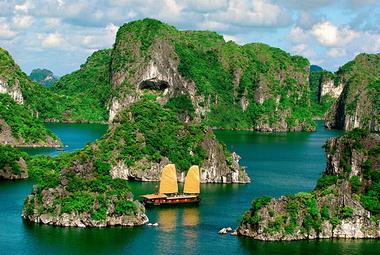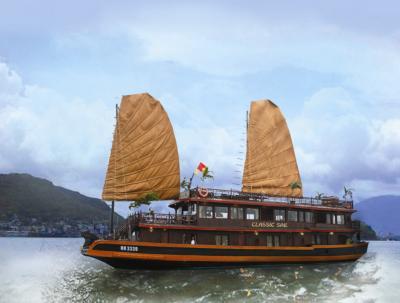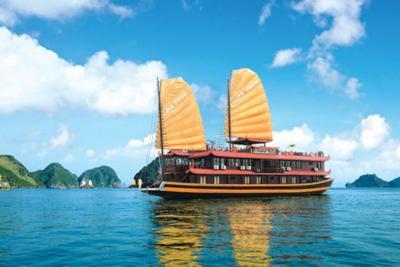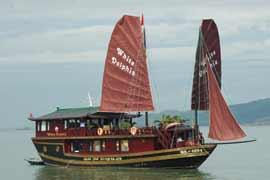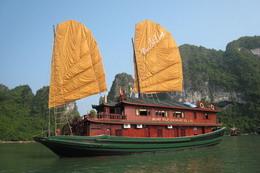Rising seas put mangrove forests at risk
Published: 09/12/2008 05:00
| VietNamNet Bridge – Viet Nam and Bangladesh are the two countries which have suffered the worst effects of rising sea levels, says Prof Nguyen Hoang Nghia of the Viet Nam Institute of Forest Science.
Surveys show that mangrove forests help reduce the devastation of tsunamis 50-70 per cent and that villages protected by salt marsh forests suffer less impact than other coastal villages. “Flood-controlling dykes built from concrete may be at risk of being breached during typhoons, but where salt marsh forests are well protected, soil dykes can stand steadily,” Nghia says. In addition, farmers and local residents often contribute to the destruction of the fragile ecosystems. “The fact remains that salt marsh forest ecosystems are cruelly demolished despite their considerable economic value and importance to protecting the coast,” Nghia says. Prof Do Dinh Sam of the institute, stated that mangrove forest ecosystems are often damaged by the development of aquatic products. “The economic value of aquatic products is immediate and tangible for farmers. Furthermore, people are unaware of the long term value of a growing forest. These factors often lead to deforestation,” says Sam. Viet Nam’s coast is 3,200km long, but mangrove forests only cover a fraction of that length. In 1943, mangrove forests covered 408,500ha, but by 2006, that area had been cut in half, according to Forest Science Institute estimates. Of the 65,963ha of mangrove forests which protect sea dykes, nearly 32,900ha are receding. The biodiversity of the forests is also in decline, especially after the damage inflicted by 2006 typhoons, which cost the country VND18.7 trillion (US$1.1 billion) in damages. Solutions The Ministry of Agriculture and Rural Development has launched a VND2.49 trillion campaign to save coastal mangrove forests. The project, which is planned through 2015, aims to restore damaged forests and prevent further destruction due to natural and man-made causes. About97,500ha of forest will be replanted, bringing the country’s total area of mangrove forests to 307,200ha by 2015. HCM City’s Can Gio salt marsh forest was successfully restored and recognised by UNESCO as a World Biosphere Reserve in 2000. Growing suitable trees is vital to the development of the forest, says Nghia. “Researchers should choose species which correspond to the type of soil, climate and condition of the area,” he says. “We also need to create an environment for the development of aquatic products in order to bring profit to local residents.” After the forest reaches a level of stability, it can be opened to the public for study and sightseeing, says Nghia. “Protecting the forest is not only the authorities’ responsibility, but also the public’s. It’s time to start thinking about ways to improve the country’s salt marsh ecosystem, which will bring profit without impacting forests,” Nghia says. (Source: Viet Nam News) |
Provide by Vietnam Travel
Rising seas put mangrove forests at risk - Sci-Tech - News | vietnam travel company
You can see more
- WIPO supports Vietnam to develop national strategy on intellectual property
- Viettel deploys 4G nationwide
- Wind power in Vietnam: three problems may shrink investors back
- Online sellers & buyers swindle each other
- Vietnam’s first remote sensing satellite launched after delay
- Vietnamese big guys vie with one another to distribute “eaten Apple”
- Broadcasters provide services below cost prices to attract more subscribers
- Vietnamese companies try to make money with garbage
enews & updates
Sign up to receive breaking news as well as receive other site updates!
- Banh Đa Cua - a traditional Hai Phong specialty
- Exploring Lai Chau cuisine
- Hanoi ranked top 3 cuisine in the world in 2023
- Beautiful resorts for a weekend escape close to Hanoi
- Travel trends in 2023
- In the spring, Moc Chau is covered in plum blossoms.
- The Most Wonderful Destinations In Sapa
- Top 3 Special festivals in Vietnam during Tet holiday - 2023
- 5 tourist hotspots expected to see a spike in visitors during Lunar New Year 2023
- How To Make Kitchen Cleaned
-
vietnam travel
http://www.vietnamtourism.org.vn " Vietnam Tourism: Vietnam Travel Guide, Culture, Travel, Entertainment, Guide, News, and...
-
Vietnam culture, culture travel
http://travel.org.vn " Vietnam culture
-
Vietnam travel, vietnam travel news, vietnam in photos
http://www.nccorp.vn " Vietnam travel, vietnam travel news, vietnam in photos
-
Vietnam tourism
http://www.vietnamtourism.org.vn " The official online information on culture, travel, entertainment, and including facts, maps,...
-
Vietnam Travel and Tourism
http://www.vietnamtourism.org.vn/ " Vietnam Travel, Entertainment, People, Agents, Company, Vietnam Tourism information.
-
Information travel online
http://www.travellive.org "Information travel online



